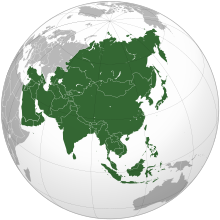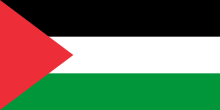Portal:Asia

 Asia (/ˈeɪʒə/ AY-zhə, UK also /ˈeɪʃə/ AY-shə) is the largest continent in the world by both land area and population. It covers an area of more than 44 million square kilometers, about 30% of Earth's total land area and 8% of Earth's total surface area. The continent, which has long been home to the majority of the human population, was the site of many of the first civilizations. Its 4.7 billion people constitute roughly 60% of the world's population. Asia shares the landmass of Eurasia with Europe, and of Afro-Eurasia with both Europe and Africa. In general terms, it is bounded on the east by the Pacific Ocean, on the south by the Indian Ocean, and on the north by the Arctic Ocean. The border of Asia with Europe is a historical and cultural construct, as there is no clear physical and geographical separation between them. A commonly accepted division places Asia to the east of the Suez Canal separating it from Africa; and to the east of the Turkish straits, the Ural Mountains and Ural River, and to the south of the Caucasus Mountains and the Caspian and Black seas, separating it from Europe. Since the concept of Asia derives from the term for the eastern region from a European perspective, Asia is the remaining vast area of Eurasia minus Europe. Therefore, Asia is a region where various independent cultures coexist rather than sharing a single culture, and the boundary between Europe is somewhat arbitrary and has moved since its first conception in classical antiquity. The division of Eurasia into two continents reflects East–West cultural differences, some of which vary on a spectrum. (Full article...) Featured articleQuneitra (also Al Qunaytirah, Qunaitira, or Kuneitra; Arabic: ٱلْقُنَيْطِرَة or ٱلْقُنَيطْرَة, al-Qunayṭrah or al-Qunayṭirah pronounced [æl qʊˈneɪ̯tˁ(ɨ)rɑ]) is the largely destroyed and abandoned capital of the Quneitra Governorate in south-western Syria. It is situated in a high valley in the Golan Heights at 1,010 metres (3,313 feet) above sea level. Since 1974, pursuant to United Nations Security Council Resolution 350 and the Agreement on Disengagement between Israel and Syria, the city is inside the UN-patrolled buffer zone. Quneitra was founded in the Ottoman era as a way station on the caravan route to Damascus and subsequently became a garrison town of some 20,000 people. In 1946, it became part of the independent Syrian Republic within the Riff Dimashq Governorate and in 1964 became the capital of the split Quneitra Governorate. On 10 June 1967, the last day of the Six-Day War, Quneitra came under Israeli control. It was briefly recaptured by Syria during the 1973 Yom Kippur War, but Israel regained control in its subsequent counter-offensive. The city was almost completely destroyed by Israel before it withdrew in June 1974. Syria later refused to rebuild the city and actively discouraged resettlement in the area. Israel was heavily criticized by the United Nations for the city's destruction, while Israel has also criticized Syria for not rebuilding Quneitra. (Full article...) Selected Country Palestine, officially the State of Palestine, is a country in the southern Levant region of West Asia recognized by 146 out of 193 UN member states. It encompasses the Israeli-occupied West Bank, including East Jerusalem, and the Gaza Strip, collectively known as the occupied Palestinian territories, within the broader geographic and historical Palestine region. Palestine shares most of its borders with Israel, and it borders Jordan to the east and Egypt to the southwest. It has a total land area of 6,020 square kilometres (2,320 sq mi) while its population exceeds five million people. Its proclaimed capital is Jerusalem, while Ramallah serves as its administrative center. Gaza City was its largest city prior to evacuations in 2023. Situated at a continental crossroad, the region of Palestine was ruled by various empires and experienced various demographic changes from antiquity to the modern era. Being a bridge between Asia and Africa, it was treading ground for the Nile and Mesopotamian armies and merchants from North Africa, China and India. The region is known for its religious significance. The ongoing Israeli-Palestinian conflict dates back to the rise of the Zionist movement, supported by the United Kingdom during World War I. The war saw Britain occupying Palestine from the Ottoman Empire, where it set up Mandatory Palestine under the auspices of the League of Nations. During this period, large-scale Jewish immigration allowed by the British authorities led to increased tensions and violence with the local Palestinian Arab population. In 1947, Britain handed the issue to the United Nations, which proposed a partition plan, for two independent Arab and Jewish states and an independent entity for Jerusalem, but a civil war broke out, and the plan was not implemented. (Full article...) Featured biographyZhou Tong (Chinese: 周同 and 周侗; pinyin: Zhōu Tóng) (died late 1121 CE) was the archery teacher and second military arts tutor of famous Song dynasty general Yue Fei. Originally a local hero from Henan, he was hired to continue Yue Fei's military training in archery after the boy had rapidly mastered spearplay under his first teacher. In addition to the future general, Zhou accepted other children as archery pupils. During his tutelage, Zhou taught the children all of his skills and even rewarded Yue with his two favorite bows because he was his best pupil. After Zhou's death, Yue would regularly visit his tomb twice a month and perform unorthodox sacrifices that far surpassed that done for even beloved tutors. Yue later taught what he had learned from Zhou to his soldiers and they were successful in battle. With the publishing of Yue Fei's 17th folklore biography, The Story of Yue Fei (1684), a new, fictional Zhou Tong emerged, who differed greatly from his historical persona. Not only was he now from Shaanxi, but he was Yue's adopted father, a learned scholar with knowledge of the eighteen weapons of war, and his personal name was spelled with a different, yet related, Chinese character. The novel's author portrayed him as an elderly widower and military arts tutor who counted Lin Chong and Lu Junyi, two of the fictional 108 outlaws on which the Water Margin is based, among his former pupils. A later republican era folktale by noted Yangzhou storyteller Wang Shaotang not only adds Wu Song to this list, but represents Zhou as a knight-errant with supreme swordsmanship. The tale also gives him the nickname "Iron Arm", which he shares with the executioner-turned-outlaw Cai Fu, and makes the outlaw Lu Zhishen his sworn brother. Because of his association with the outlaws, he is often confused with the similarly named outlaw Zhou Tong. (Full article...) General imagesThe following are images from various Asia-related articles on Wikipedia. Featured picture Credit: Jonas Satkauskas Kaindy lake in south-east of Kazakhstan. The mountain lakes like this form after the landslide blocks the mountain river. The trunks are dead Picea schrenkiana trees.
Did you know...
Updated: 6:33, 14 February 2024 In the news
Related portalsMajor Religions in Asia Middle East Central Asia and Surroundings Indian Subcontinent Southeast Asia East Asia Selected panorama
The Central Area of Singapore surrounded by the perimeter of five planning areas: the Marina Bay, the Downtown Core, Marina East, Marina South and Straits View. The area surrounding the bay itself, also called Marina Bay, is a 360 hectare extension to the adjacent CBD. It is also the new downtown of Singapore built on reclaimed land. TopicsCategoriesAssociated WikimediaThe following Wikimedia Foundation sister projects provide more on this subject:
More portalsShortcuts to this page: Asia portal • P:ASIA Purge server cache |































































































